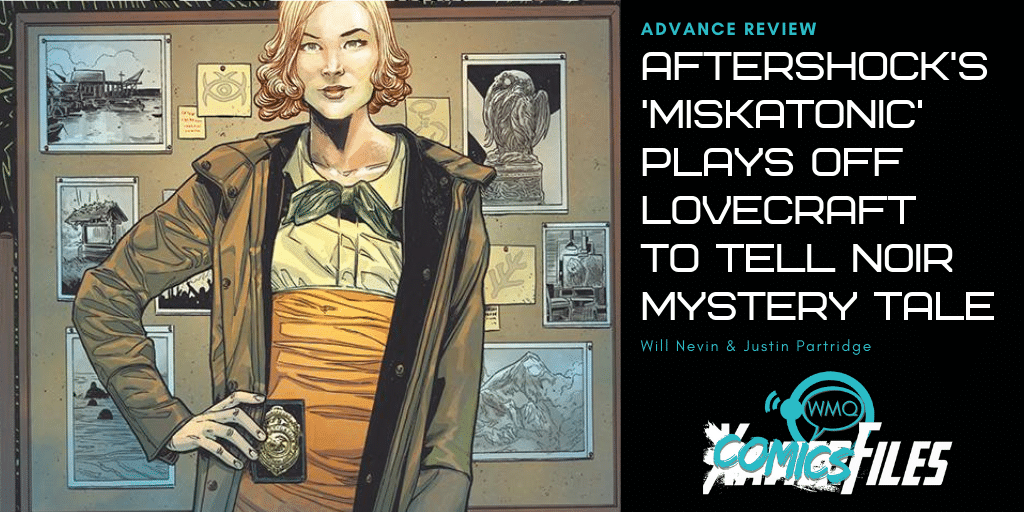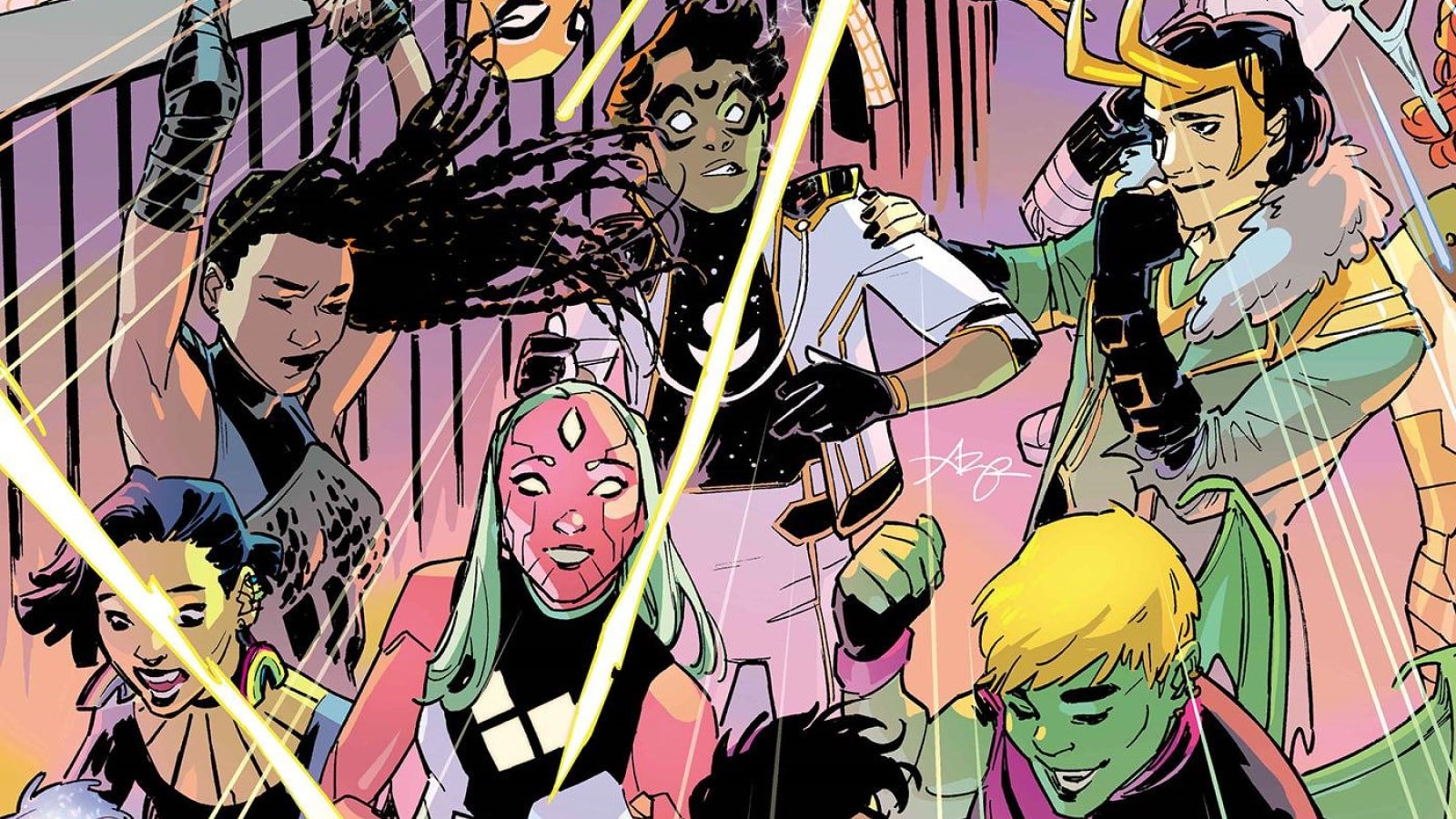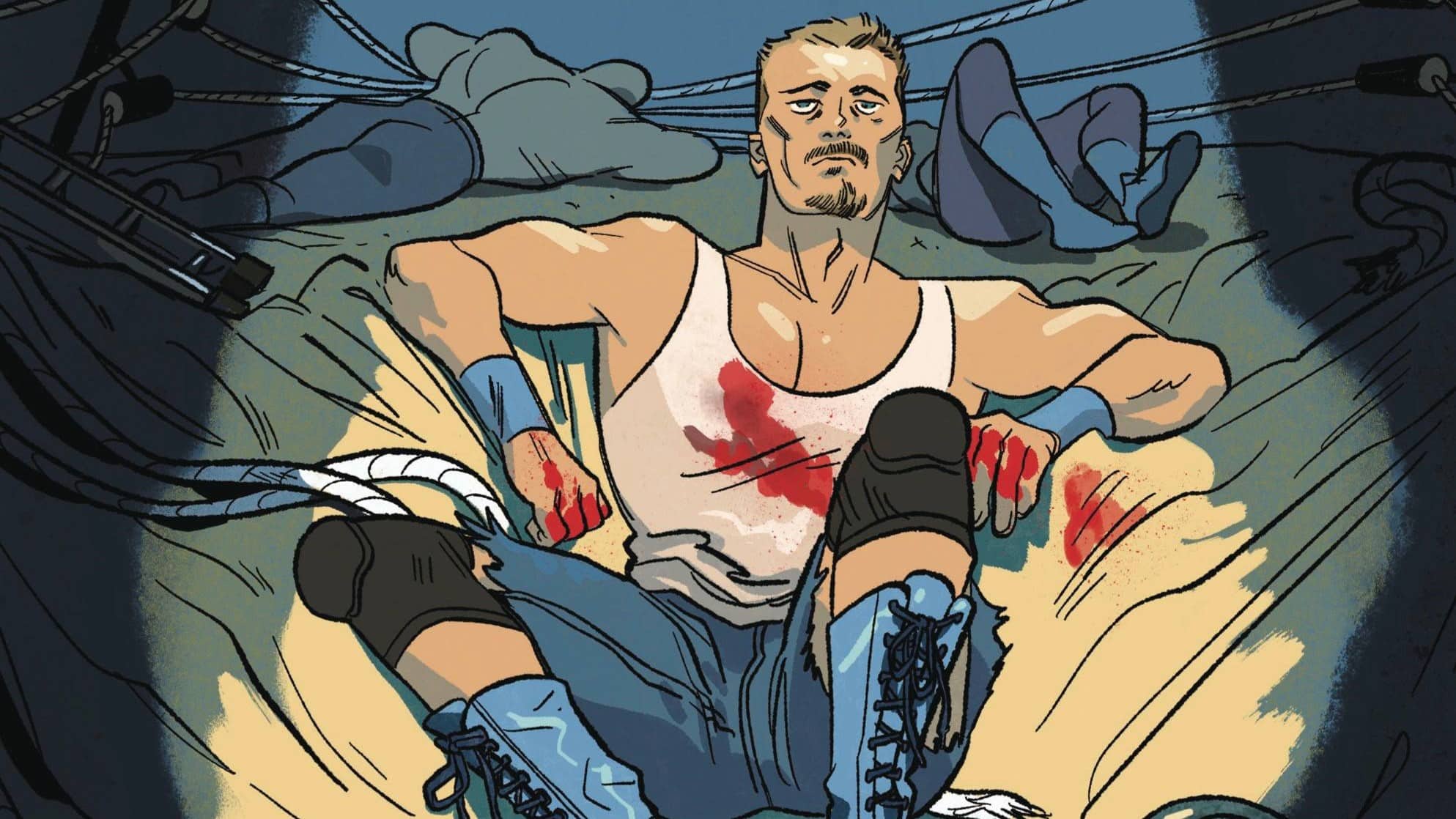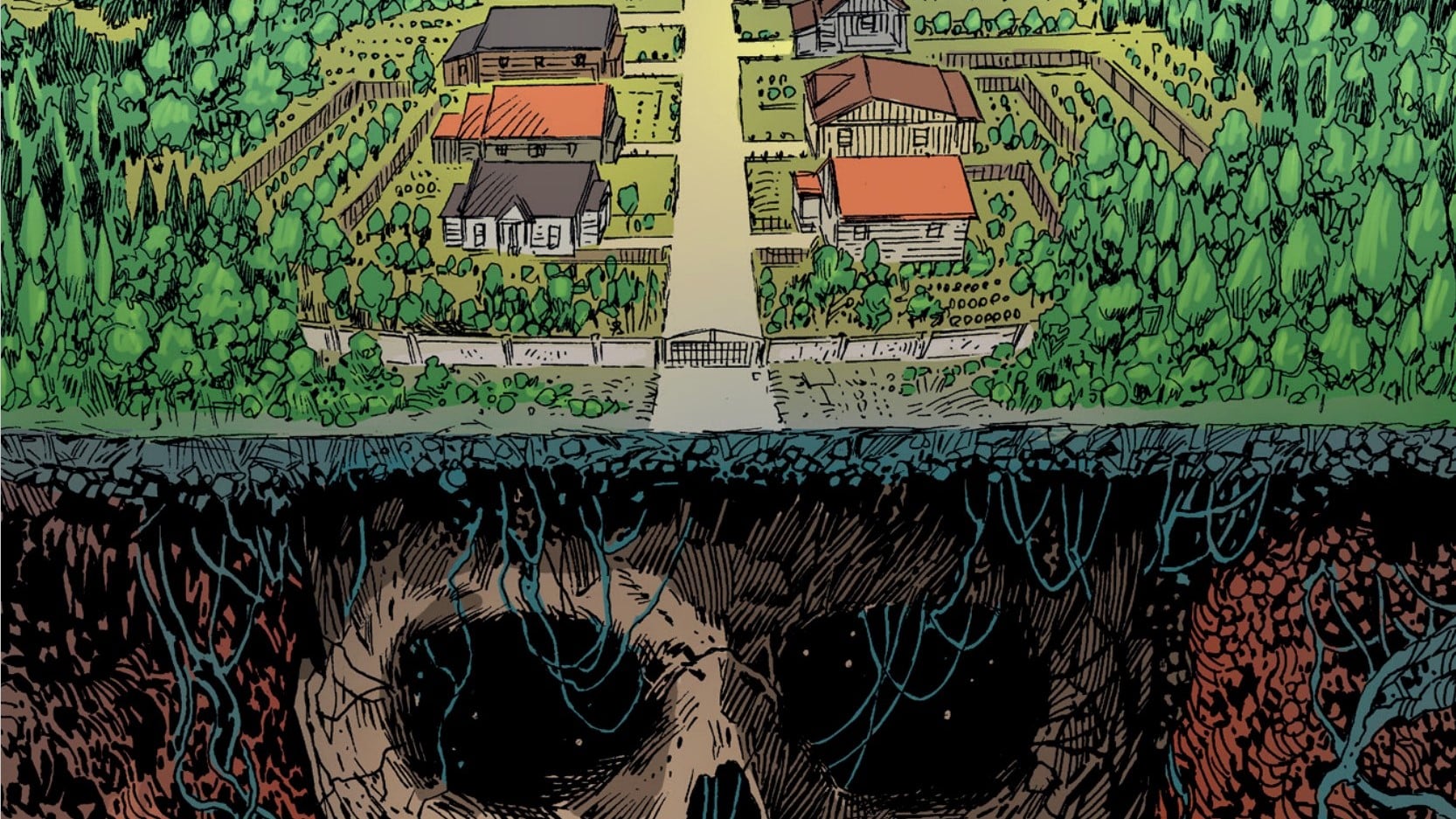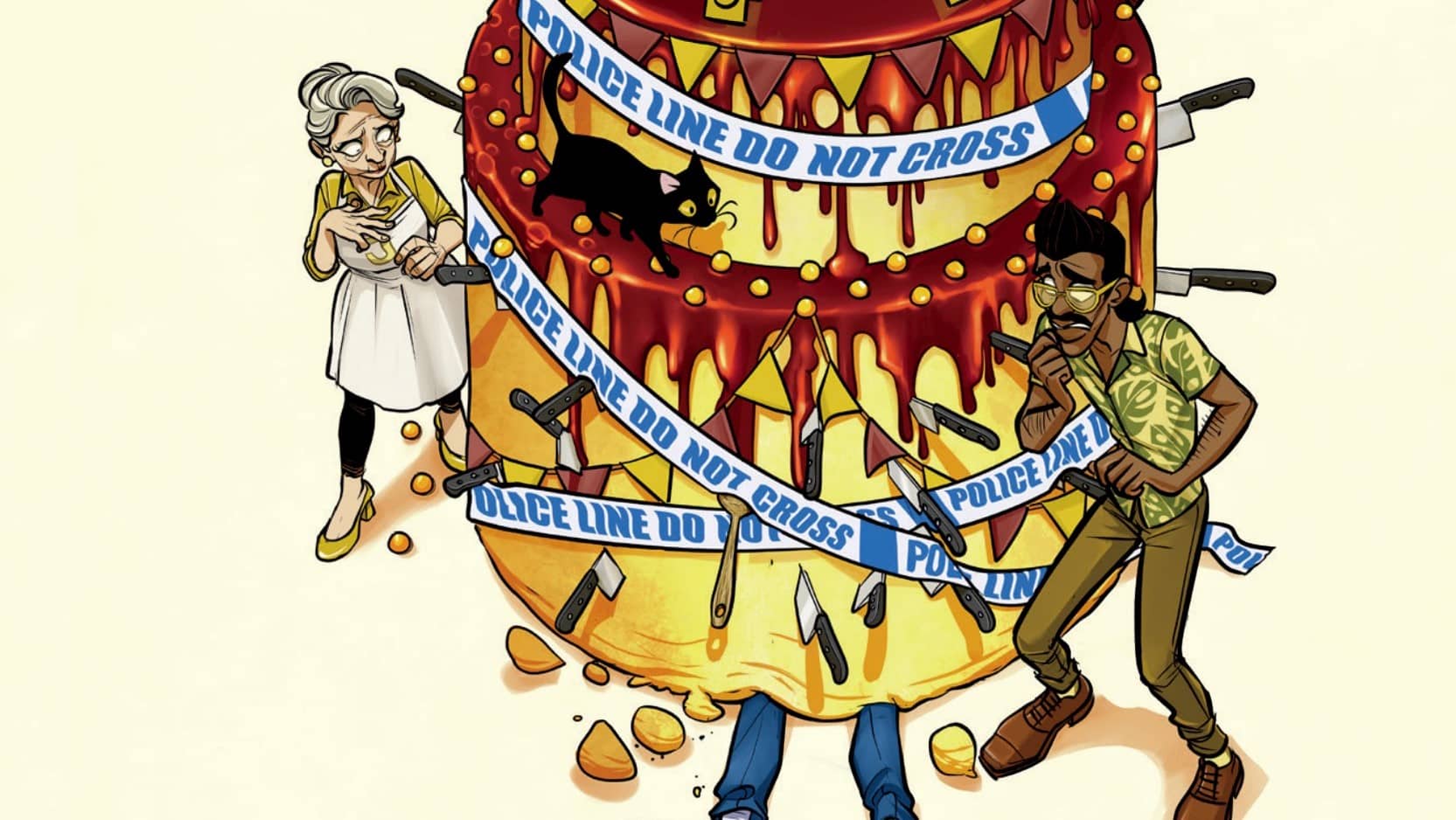In its solicit text, AfterShock’s “Miskatonic” promises “a mix of historical crime fiction and Lovecraftian horror that dives deep into the American nightmare.” Let’s get into the new series from Mark Sable, Giorgio Pontrelli, Pippa Bowland and Thomas Mauer and see if it pays off those dark and abominable promises.

Will Nevin: My tastes in comics are pretty simple: I like a Batman who doesn’t look like a Power Ranger and occasionally uses his brain instead of his fists or a Batrocket, I’ll read any book where some evil cur needs a killin’ and gets killed, and noir is — and I mean this in the best way — the absolute tits. Alternate history? Gimme that good shit, too.
So when I saw that “Miskatonic,” the new AfterShock series from writer/creator Mark Sable and artist Giorgio Pontrelli, is a little noir and a little alternate/hidden history and a lot of H.P. Lovecraft, I was interested — but plenty wary of taking it on since I know generally two things and only two things about Lovecraft: (1) He dreamed of the sort of things that we’d normally only see in possum genitalia, and (2) He was incredibly racist. To figure out whether this inside-baseball cosmic horror comic can work, I knew I needed help.
So I called in an expert.
Justin Partridge: That’s me! I’m supremely uncool!
[WN interjection: Justin is super cool.]
[Grote’s note: Can confirm.]
I became an “expert” in the ways and lore of HPL by virtue of having little to no friends and romantic prospects in high school, which found me staring at the stars and wondering what horrors lurked out there beyond the ken of my limited perspective of reality. Bit like Ol’ Howie himself back in the 1910s.
The only difference being, I actually became a semi-functioning adult and not a frothing, cloistered bigot, obsessed with the sex he’s not having and the incresing amount of Italians in his town. I devoured his works, along with the works of his inspirations like Byron, Dunsay and August Derleth (arguably the “superior” Lovecraftian writer) and then just kept on from there, reading other works of cosmic horror (Brian Lumley, Arthur Machen and more Clive Barker, just to name a few) while also becoming quite an active player/game master of Chaosium’s “Call of Cthulhu” TTRPG, my favorite gaming system.
I have a fondness for the works of Lovecraft (mainly the weirder Dream-Quest/Randolph Carter stuff and not the obviously thuddingly racist stories), but the REAL love I came out of Lovecraft with was cosmic horror, the genre he is credited with “creating” (though that’s a WHOLE other column) but perfected by various other writers in the wake of his death. And I think, by that metric and by actively commenting on the legacy of Lovecraft and his “Cthulhu Mythos,” “Miskatonic” #1 is a pretty great effort. “Honoring” the Mythos with a pretty fun and tense horror mystery while poking specifically at the time’s horrifying politics, policing and gender roles is the best-case scenario, to be honest, for a “modern” Lovecraftian franchise.
WN: The way I see it, pardner, is that we’ve got three questions to settle: whether this works as Lovecraftian subtextual commentary, whether the actual text succeeds in telling a good story and whether our good readers should pick this up when it drops this week.
JP: I am more than willing to take that on. What are we waiting for?! IA! IA! CTHULHU FLAGTAGEN, MY DUDES!
WN: Don’t make me turn the hose on you.
Lovecraft: He Was a Bad Guy

WN: Here’s where I have to lean on you the most, Justin. What do we really need to know about Lovecraft and his work going into this series? The solicit makes me think that, while it’s not exactly deep-cut stuff, it’s not the sort of knowledge your average comics fan is going to have. At least I didn’t anyway.
JP: No, totally, and the creative team even leans into THEMSELVES by making “Miskatonic” #1 seemingly a side-sequel to two major works of the Mythos canon: “The Shadow Over Innsmouth” and “The Horror at Red Hook,” both of which being some of Howard’s “transition” stories, moving away from standalone pulp stories and into a more “controlled” set of serials aiming to build out his “Cthulhu Mythos.”
The “Innsmouth” connection is more explicit here than the “Red Hook” connection, but both I feel are equally important to understand within the context of this first issue, because it seems like Sable is coming at them both with explicit commentary on each (which I think is one of the issue’s great strengths).
Basically, the short version is, “Innsmouth” was one of HPL’s first major Mythos stories because it explicitly and for the first time in his stories connected humanity to one of his Great Old Ones. Namely Dagon, a sort of Triton mixed with The Gill Man from “Creature from the Black Lagoon,” who became the “patron God” to the people of Innsmouth after they discovered each other when a mighty storm swept through their port town. The creatures (called “Frog-Men” in the story but later given their proper title as “Deep Ones” in a later story) entered into a…shall we say, mutually beneficial relationship with the people of Innsmouth. Meaning they would provide a more stable fishing and export economy for the town — in exchange for getting to fuck the humans, spawning generations of half human/half Deep One worshippers and starting the “Innsmouth look” (greenish skin, large amphibious eyes and croaking voices) for their ancestors.
Though the original story itself is a pretty nakedly written “horror story” about miscegenation (something Howard himself was wildly, hilariously opposed to) and the “loss of self” that came with laying with those not of your kind (another BIG pillar of “Red Hook”), the story sets itself apart by being one of the few Mythos stories in which humanity and the Old Ones had a sort of beneficial and reciprocal relationship. Usually in these stories the Old Ones either hate us or are largely indifferent toward us, allowing us to blast our minds and bodies apart just to get near them, but in “Innsmouth” they all seem pretty OK with it, going so far as to self-isolate their town to preserve the relationship and appease their patron to a further extent.
“The Horror at Red Hook” is a little more… dicey. Following Detective Malone (the same Tom Malone we see in “Miskatonic” #1), the story posits a Red Hook that is being slowly overtaken by a “foreign menace,” the dusky followers of a new “church” that has been popping up throughout the world. Poking into the “church” further, Malone discovers *GASP!* they are actually an Old One cult — and they have designs on taking over the patch of land as a foothold in the holy and lily white AMERICA!
Again, pretty overt racism and fear of “being overrun” by foreign influence at play there. But here, it seems like Sable is using the text and problematic politics of the original works to actively comment and exemplify just how horrible the politics of those stories were, while also using it as a pretty solid foundation for our lead character here, Agent Miranda Keller.
He also seems to be going the extra mile to establish her as being a full cast member of the Mythos as well, pairing her not only with Malone but giving us a Zadok Allen cameo (Zadok being from the original text of “Innsmouth” and the only full human still allowed to live in the town), mentions of Arkham, Massachusetts (one of HPL’s major story settings), and multiple other shoutouts to Mythos tales.
Have I already lost you, Will? Is this all just TOO egghead, or did you pick up any of this?
WN: Admittedly, I’m lost as hell, but I’m happy to know that the original works picked up on the fish fuckin’ and this wasn’t some weird tangent Sable and Co. decided to go off on. (For the record, #nokinkshaming.) This is maybe getting too close to our final, bottom-line point, but if folks don’t know much about Lovecraft, is this something they should even mess with? What’s a half-decent primer? I thought the back matter was an attempt at giving a little more context, but I think I would have preferred an academic essay rather than what we got.
JP: NO, TOTALLY! And that back matter is a wonderful example of the kind of world-building that Lovecraftian stuff and games like to play around in. Call of Cthulhu the TTRPG especially relies pretty heavily on “handouts” and scraps of printed clues player characters can find to further their investigations.
But that’s a great question, and something, as a “Lovecraft person,” I have run into when trying to articulate why he matters (while also sucking so profoundly as a human and writer). Honestly?! I think I could give someone “Miskatonic” #1 and be OK with it representing the “brand” and tone of a Lovecraftian book. I would be damned sure to give them THIS before I would give them something like Neonomicon or even an actual HPL volume. I think this issue and series especially looks to be grappling with the legacy and problematic baggage of HPL in a way that I think could speak to a modern audience way better than some of the original works ever could. Your mileage always varies with him because there is always that asterisk (not that one) that yes, a lot of this stuff “matters” arguably to the canon of horror literature but also comes from a bigoted, almost operatically stunted human being that lived with his gay aunts and a thousand cats and never saw a boob once.
(WN interjection: I’m not saying the sadness of never seeing a boob is an excuse for his bullshit…but, man, what a bummer.)
That said, I think this issue would truly be a good starting point, though I worry the weight of the heavy texture and callouts to the HPL stories might turn off newcomers. From there, should you want any real-deal further reading, “At the Mountains of Madness” is a truly fantastic read (and is largely clear of his overtly racist bullshit and more infused with his cosmic daemon god bullshit) and Penguin Classics has an awesome collection of his full works, if you can ignore the snobbishly fawning and disgustingly centrist academic commentary from Lovecraft “scholar” S.T. Joshi provided in those collections (as he is all over the resortations and collections of HPL’s works). There is this weird thing you will find, especially if you start reading collections and academic explorations of his work, that a lot, and I mean A LOT of Lovecraft people will extol his “importance” to the Western canon but never once engage with his racism and bigotry (which is…not really engaging with his work, now is it?), and Joshi is absolutely the root of that disconnection. Jess Nevins eats his lunch any day of the week. But I digress…
Part of me just wants everybody to watch all of Stuart Gordon’s movies and then just be done with it, but I think, should you seek out the work and try to grapple with it as just an empathetic human being, you’ll get SOMETHING out of it, for sure. “Cool Air” legitimately rips tho…
The Rest of the Story: Noir with a Big Boom

WN: I might have a thousand gripes with this book (which I don’t really, but roll with me here for a second), but I cannot crap on the opening: A guy opens a mail bomb in his house and gets blowed to pieces. A nice way to open the book, wasn’t it?
JP: Oh, big time, and it’s a fun stab of “action” into a Lovecraftian story, which you don’t often see. A lot of the time when people say they want their stuff to be “Lovecraftian,” what they really mean is that their stuff is actually kinda crazy stuffy, slowly paced and laden with “purple prose.” BUT THIS?! This grabs the reader by the collars early and establishes that “Miskatonic” #1 is going to be a pretty damn sight more active than a lot of other cosmic horror efforts.
WN: Another thing I liked was just the overall vibe — this reminded me at least a little of HBO’s “Perry Mason,” which we both agree is a series that fucks. “Miskatonic” is not quite on that level, but I thought it’s at least in that neighborhood in terms of setting the right tone and digging in that same time period. (“Perry Mason” is set in 1932, “Miskatonic” eight years earlier. Close enough.)
JP: OH ABSOLUTELY! God, that new Perry Mason was so good. But again, I think this is a stylistic choice on the part of Sable and the art team. Like, as you are probably aware, a lot of “Lovecraftian” stuff tends to be period pieces. This both works for and against those efforts. It works for them because you are allowed a greater range of stunted emotionality and historical context to work with, which will allow the stories to work better.
For example, you can get away with your characters being outwardly racist and paranoid in the way that you need Lovecraftian protagonists to be to sell the “feelings” and tonality of the story. But at the same time, that also fences you in and hobbles your characters somewhat because who wants to read about a racist shithead in the ’20s who gets zapped by a god from space?
But here, I think Sable nestles it into a very interesting time period, both for the Mythos works and American history in general. We are pretty much at the peak of Prohibition here. Hoover has just been installed as acting director of the FBI. And America itself was at a tipping point toward the first major “modern” pushes toward racial equality, women’s suffrage and science-based policing. Now does some of this stuff work? Not really. The “more progressive FBI” stuff is particularly hilarious, knowing what we now know about Hoover and the graphically inept and terrifying efforts he put into keeping up Jim Crow in the Southern states
But honestly, I think the issue works more as a piece of pulp than it does a piece of historical fiction (but I so appreciate the detailing as a reader).
WN: I’d agree there — it has nods to history (including Hoover being a part of some compromising photos), but it certainly doesn’t attempt to be a historical treatise. Given the weight of the Lovecraft analysis already on top of it, I’d hate to see it try.
JP: Oh, totally. There is a real sense of self-awareness here from Sable that I think sets it apart from other “Lovecraftian” comics of the here and now. So many of those want to be “important” works or make some kind of grand statement on the subgenre, but they always forget to actually be fun to read and engage in the outward horror elements of it.
This thing has a Deep One on Human ORGY in it for Yog-Sothoth’s Sake! That’s FUN AS HELL! And terrifying to…most people. But y’all get it, “Miskatonic” #1 seems kinda stuffy at first, but reveals real fun and smarts. Maybe a bit too much of the latter.
Overall…a Meh from Will?

JP: I think I am a little hotter on the opener than you are, but overall, it’s a pretty functional little slice of Weird Fiction. One that very clearly has some people behind it that are into the original works and have an intention to not just slavishly extol their “brilliance,” but to contextualize them for a more aware and savvy audience. All while using the materials to not excuse the problematic elements, but at least wrestle with them somewhat and to try to speak on them beyond just “cool tentacle monsters” and “monster-on-human sex.” But there is still that as well, which is a major plus in my books.
The only other REAL comparison I could draw is Alan Moore and Jacen Burrows’ “Providence,” but I haven’t read that enough to make a sound judgment. I have HEARD and read that that one really takes Howie to task, both for his shit protagonists and for his horrible politics within the scope of another “cosmic horror” story, but I dunno. I feel like people that aren’t crazy into this stuff like I am or that are JUST fans of period mysteries might not get as much out of it as they should as a #1.
WN: Oh shit, an “Avatar” shout-out that was neither “Crossed” nor something written by a sex creep. Who knew that was possible?
JP: HEH. YA BURNT, COMICS CAVALCADE.COM! (also please send me those new collections of “Providence,” please and thank you).
WN: My bottom line is that I’m fairly down on this for three reasons: (1) the pacing, both overall and from panel to panel in some spots, (2) the density of the references and (3) the art. Some of the pacing here is all off; in the micro, it comes in at mistimed page turns and other weird moments, such as a chase scene in which we’re told of the fish-men horrors, but we don’t actually see them. There’s another odd spot in which the Lady Agent says, “I’m not going to hide in a Klan outfit,” to which her partner responds, “We don’t have time to argue,” only for them to not end up in said Klan robes. The overall pacing/storytelling issue is that these characters have no depth — all we know about Lady Agent is that she’s a lady agent, and while there’s time for that to get fleshed out, it’s easier to do so when she’s not running from fish fuckers, fishes who fuck men and half-fish, half-men who are probably DTF.
And because of (1), it only makes (2) an even bigger problem. I don’t mind going to a party and not getting all of the in-jokes, but it had better be a goddamn fun party. This story doesn’t click hard or fast or smooth enough for me, Idiot Man Who Knows Nothing About Lovecraft, to continue to invest time and dollars into the series.
And as to (3), there’s a splash page near the end that’s set up to be this big shocking moment, and, either because of whatever lighting effect the art team attempted or some other reason, it just came off as indie house-style mediocrity.
JP: AND THIS IS ALL TREMENDOUSLY VALID CRITICISM!
This was why I was saying earlier that I think this might turn off newcomers in that the scene with Zadok and the aforementioned splash page (in which a cultist explicitly names “DAGON!”) that played like a mic-drop moment. And for people who know who the fuck Dagon and Zadok Allen are, I am sure it is, but like you said, nobody likes being left out.
That said, I also think this #1 is functional enough to hook someone with these shoutouts and maybe even spark them to seek out some further reading. I will absolutely agree with you about the pacing, though. It’s super frontloaded with a lot of exposition around Miranda and how she is able to pull the assignment to investigate the bombing, which is even then further overlaid with a LOT of shoe-leather about Innsmouth and Malone, ALONG with the history stuff. It gets to be a lot, and yes, the scene composition is also very juttering at points.
Part of me wants to also say this might be a style choice on the part of the creative team, emulating the sort of janky and slapdash scene construction of the old pulps, but that feels apologist. Even for ME. I am left not feeling colder on it, but at least more aware of its flaws as a series opener.
That Deep One orgy tho…
WN: It’s a big pile of fish people fucking. You can’t be too down on a book with that.
Mi-Go Mailbag
- So we are guessing this is just a miniseries, but we could absolutely see this having legs as an ongoing. Maybe like a Lovecraftian Castle Rock where every arc is Miranda investigating a new “story” in the Mythos. Would very much be into full-on woke adaptations “The Haunter in the Dark,” “Rats in the Walls” or even “Call of Cthulhu” (which is also…a far sight more racist than people realize or admit, I guess, LOL).
- Also AfterShock really seems to be going out of their way to give this a neat “style” all its own with a bunch of variants and the neat neon green title page. We hope that continues in the future.
- If you are looking for fun modern lovecraftian comics, here are a few examples to get you started: Fred Van Lente’s “Weird Detective” (which is a very funny “Nice Guys”-like mystery with brain-sucking monsters), Lonnie Nadler and Jenna Cha’s “Black Stars Above” (which is Arthur Machen-as-Fuck), and Black Mask’s “There’s Nothing There” (which is like Lovecraft-Goes-Hollywood).
- Here’s a thing from the FBI about the bombing campaign referenced in “Miskatonic.”
- If anyone wants to play Call of Cthulhu with Justin, he will run your game in a heartbeat. It is a fun system for people wanting a less combat-heavy TTRPG experience.

